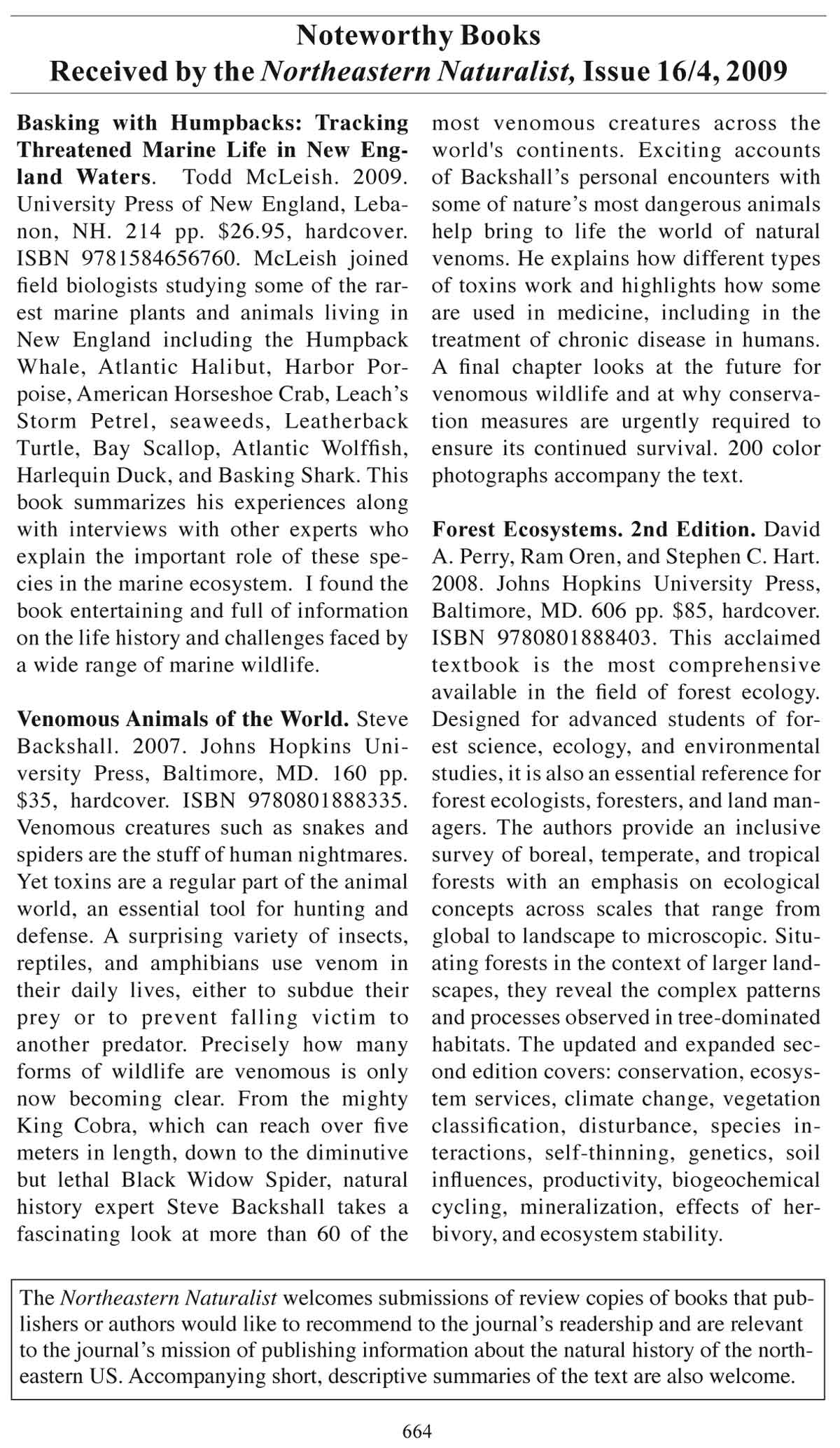Access Journal Content
Open access browsing of table of contents and abstract pages. Full text pdfs available for download for subscribers.
Current Issue: Vol. 30 (3)

Check out NENA's latest Monograph:
Monograph 22









Noteworthy Books
Received by the Northeastern Naturalist, Issue 16/4, 2009
Basking with Humpbacks: Tracking
Threatened Marine Life in New England
Waters. Todd McLeish. 2009.
University Press of New England, Lebanon,
NH. 214 pp. $26.95, hardcover.
ISBN 9781584656760. McLeish joined
field biologists studying some of the rarest
marine plants and animals living in
New England including the Humpback
Whale, Atlantic Halibut, Harbor Porpoise,
American Horseshoe Crab, Leach’s
Storm Petrel, seaweeds, Leatherback
Turtle, Bay Scallop, Atlantic Wolffish,
Harlequin Duck, and Basking Shark. This
book summarizes his experiences along
with interviews with other experts who
explain the important role of these species
in the marine ecosystem. I found the
book entertaining and full of information
on the life history and challenges faced by
a wide range of marine wildlife.
Venomous Animals of the World. Steve
Backshall. 2007. Johns Hopkins University
Press, Baltimore, MD. 160 pp.
$35, hardcover. ISBN 9780801888335.
Venomous creatures such as snakes and
spiders are the stuff of human nightmares.
Yet toxins are a regular part of the animal
world, an essential tool for hunting and
defense. A surprising variety of insects,
reptiles, and amphibians use venom in
their daily lives, either to subdue their
prey or to prevent falling victim to
another predator. Precisely how many
forms of wildlife are venomous is only
now becoming clear. From the mighty
King Cobra, which can reach over five
meters in length, down to the diminutive
but lethal Black Widow Spider, natural
history expert Steve Backshall takes a
fascinating look at more than 60 of the
most venomous creatures across the
world's continents. Exciting accounts
of Backshall’s personal encounters with
some of nature’s most dangerous animals
help bring to life the world of natural
venoms. He explains how different types
of toxins work and highlights how some
are used in medicine, including in the
treatment of chronic disease in humans.
A final chapter looks at the future for
venomous wildlife and at why conservation
measures are urgently required to
ensure its continued survival. 200 color
photographs accompany the text.
Forest Ecosystems. 2nd Edition. David
A. Perry, Ram Oren, and Stephen C. Hart.
2008. Johns Hopkins University Press,
Baltimore, MD. 606 pp. $85, hardcover.
ISBN 9780801888403. This acclaimed
textbook is the most comprehensive
available in the field of forest ecology.
Designed for advanced students of forest
science, ecology, and environmental
studies, it is also an essential reference for
forest ecologists, foresters, and land managers.
The authors provide an inclusive
survey of boreal, temperate, and tropical
forests with an emphasis on ecological
concepts across scales that range from
global to landscape to microscopic. Situating
forests in the context of larger landscapes,
they reveal the complex patterns
and processes observed in tree-dominated
habitats. The updated and expanded second
edition covers: conservation, ecosystem
services, climate change, vegetation
classification, disturbance, species interactions,
self-thinning, genetics, soil
influences, productivity, biogeochemical
cycling, mineralization, effects of herbivory,
and ecosystem stability.
The Northeastern Naturalist welcomes submissions of review copies of books that publishers
or authors would like to recommend to the journal’s readership and are relevant
to the journal’s mission of publishing information about the natural history of the northeastern
US. Accompanying short, descriptive summaries of the text are also welcome.












 The Northeastern Naturalist is a peer-reviewed journal that covers all aspects of natural history within northeastern North America. We welcome research articles, summary review papers, and observational notes.
The Northeastern Naturalist is a peer-reviewed journal that covers all aspects of natural history within northeastern North America. We welcome research articles, summary review papers, and observational notes.